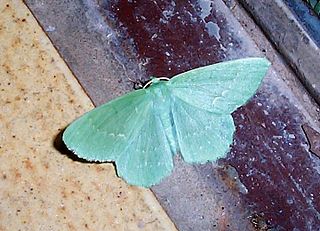
The large emerald is a moth which is the type species for the family Geometridae. It is found throughout the Palearctic region and the Near East in and around deciduous forests, heathlands, marshland and in settlements close to woodland. The species was first described by Carl Linnaeus in his 1758 10th edition of Systema Naturae.

Mythimna ferrago, the clay, is a moth of the family Noctuidae. The species was first described by Johan Christian Fabricius in 1787. It is distributed throughout Europe and is also found in Morocco, Algeria, Turkey, Asia Minor, Armenia, Syria, Turkestan, Israel, Lebanon, Iraq, Iran, Central Asia and the western parts of temperate North Asia. Also Tibet.

Geometrinae is the nominate subfamily of the geometer moth family (Geometridae). It is strongly split, containing a considerable number of tribes of which most are presently very small or monotypic. These small moths are often a light bluish green, leading to the common name of emerald moths, though a few species called thus are also found in the tribe Campaeini of the Ennominae. In 2018, a phylogeny and classification based on a molecular phylogenetic analysis was published in the Zoological Journal of the Linnean Society in which 13 tribes were accepted.
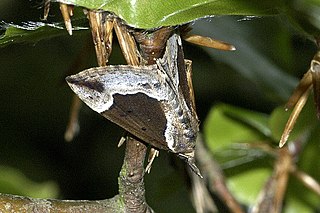
Hypena crassalis, the beautiful snout, is a moth of the family Erebidae. The species was first described by Johan Christian Fabricius in 1787. It is found in Europe.

Thetidia is a genus of moths in the family Geometridae.

Eupithecia venosata, the netted pug, is a moth of the family Geometridae. It was first described by Johan Christian Fabricius in 1787. It is found across the Palearctic realm from Portugal and Morocco in the west to the Lake Baikal in Siberia and Afghanistan and Pakistan in the east.

Gagitodes sagittata, the marsh carpet, is a moth of the family Geometridae. The species was first described by Johan Christian Fabricius in 1787. It is found in eastern Asia, including Japan, Korea and China and in central and northern Europe. It is sometimes included in the genus Perizoma
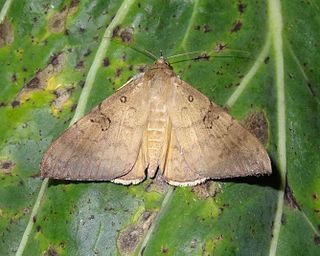
Oxyodes scrobiculata, the longan semi-looper or longan leaf-eating looper, is a moth of the family Erebidae. The common name "looper" is used despite looper moths generally being in the family Geometridae. The species was first described by Johan Christian Fabricius in 1775. It is found in the Indo-Australian tropics of India, Sri Lanka, Myanmar, China, east to Guam, Queensland, New Caledonia, Fiji, Samoa and Tonga.

Prochoreutis myllerana, Miller’s nettle-tap or small metal-mark, is a moth of the family Choreutidae found in Asia and Europe. Miller's nettle-tap was first described by Johan Christian Fabricius in 1794 from a specimen found in Sweden.

Roeslerstammia erxlebella is a moth of the family Yponomeutidae. It is found in all of Europe, east to Japan.

Olindia schumacherana, also known as the white-barred tortrix, is a moth of the family Tortricidae found in most of Europe. The moth was first described by the Danish zoologist, Johan Christian Fabricius in 1787.

Acontia nitidula, the Brixton beauty, is a moth of the family Noctuidae. The species was first described by Johan Christian Fabricius in 1787. It is found in South Africa, Europe, China, Japan and throughout India and Sri Lanka. It has also been recorded from Great Britain, but this record is doubtful.

Micropterix tunbergella is a moth of the family Micropterigidae found in most of Europe. The moths are very small and can be found feeding on the pollen of hawthorn, oak and sycamore. The larva and pupa are unknown. The moth was described Johan Christian Fabricius in 1787.

Synchlora aerata, the wavy-lined emerald moth or camouflaged looper, is a species of moth of the family Geometridae. The species was described by Johan Christian Fabricius in 1798. It is found in the United States and Canada.
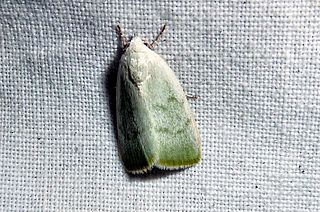
Earias vernana is a species of moth in the family Nolidae first described by Johan Christian Fabricius in 1787. It is found in most of southern and central Europe.
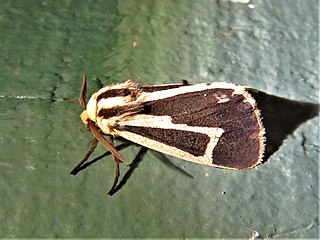
Apantesis vittata, the banded tiger moth, is a moth of the family Erebidae. It was described by Johan Christian Fabricius in 1787. It is found in the United States from Maryland to Florida, west to Kentucky and Louisiana.
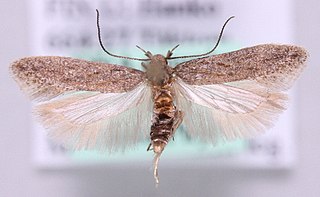
Scrobipalpa nitentella, the common sea groundling, is a moth of the family Gelechiidae. It is found in most of Europe, North Africa (Tunisia), Turkey, Afghanistan, Kazakhstan, China, Mongolia and Siberia (Transbaikalia).
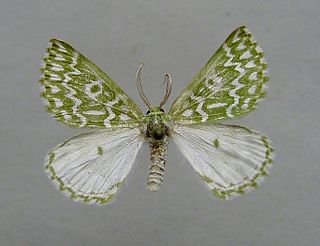
Thetidia plusiaria is a moth of the family Geometridae. It is found in central and eastern Spain, the Pyrenees, on Mallorca, as well as in Algeria and Morocco. In the mountains, it is found up to altitudes of about 2,400 meters.

Hypopyra vespertilio is a moth of the family Erebidae first described by Johan Christian Fabricius in 1787. It is found in China, Korea, Honshu in Japan, India, Sri Lanka, Nepal, Thailand, Myanmar, Cambodia, Vietnam, Taiwan, Malaysia, the Philippines, Java, Sumatra and Sulawesi.

Perina nuda, the clearwing tussock moth or banyan tussock moth, is a moth of the family Erebidae. The species was first described by Johan Christian Fabricius in 1787. It is found in the Indian subregion, Sri Lanka, to southern China Hong Kong, Thailand and Sundaland.






















